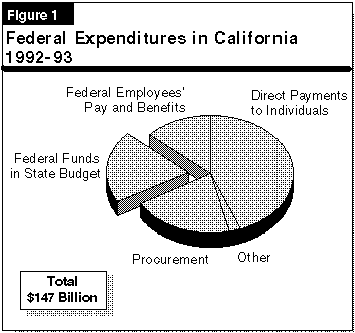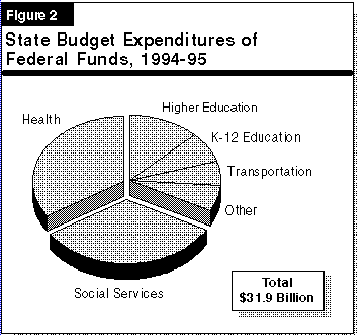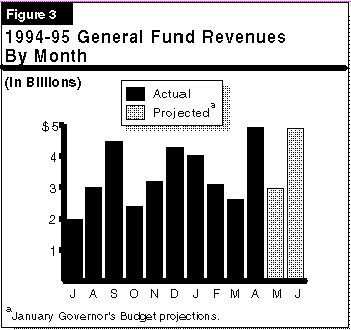

Congress is currently focusing much of its attention on proposals that would have significant impacts on the state's budget and on the way in which the state and local governments operate many programs. On April 25, we presented an overview of the impact of federal spending and tax proposals on California to the Joint Legislative Budget Committee. This Update presents the highlights of that overview.
The federal government spent about $147 billion in California in 1992-93 (the latest figures available). Figure 1 shows that about 80 percent of this spending occurred outside the state budget. Direct payments to individuals (primarily for Social Security and Medicare benefits) accounted for the largest single share of spending (44 percent). Federal procurement spending for defense and other programs, plus pay and benefits for federal employees located in California, accounted for a third of total federal spending in the state. California local governments also received between $2 billion and $3 billion directly from the federal government, although most of the federal funds which local entities receive are "passed through" from the state.

The Governor's Budget estimates that the state will spend $31.9 billion of federal funds in 1994-95, either directly or through grants to local agencies. Figure 2 shows how this spending is allocated among program areas. Programs in the health and social services areas receive two-thirds of the funds. Most of the health spending is for Medi-Cal services. Major social service expenditures include unemployment benefits, welfare grants under Aid to Families with Dependent Children (AFDC), and payments to counties for welfare administration. Spending for higher education includes funding for the national laboratories operated by the University of California for the U.S. Department of Energy.

Pending Congressional Actions. Congressional actions have proceeded along two tracks. One track involves budget-related actions. The other track involves a group of bills passed by the House to implement several portions of the Republican Contract with America and which are now awaiting Senate action.
The recissions bill now awaiting final passage would reduce currently budgeted federal spending by $16.4 billion. California's share of the reduction would be about $1.6 billion, but only a portion of this reduction would pass through the state budget. The largest cuts in federal funds to California relate to:
The recissions legislation, however, also includes $6.7 billion for disaster relief, a large portion of which will come to California.
The three measures below that were passed by the House would have a significant fiscal impact on California.
Personal Responsibility Act of 1995 (HR 4). This bill substantially revises several major public assistance programs, including AFDC, child protection and nutrition, Supplemental Security Income, and food stamps. Some programs that currently are open-ended entitlements, primarily AFDC, would be changed to block grants. Benefits to legal immigrants would be greatly restricted. Funding reductions, caps on growth, and restrictions on eligibility would significantly reduce federal funding for these programs compared with current trends both nationally and in California.
Over the next five years, the bill would reduce federal spending on public assistance programs in California by $13 billion compared with current trends. The impact on spending from state funds could range from a net savings of roughly $2 billion (if the state conforms its policies to the federal changes) to a net cost of about $13 billion (if the state backfills the reduced federal funds and maintains current program policies). A more detailed discussion of this legislation's impact can be found in our recent brief entitled Personal Responsibility Act of 1995: Impact on California (see back page).
Taking Back the Streets Act (HR 3). This bill would change many of the provisions of the federal crime bill enacted in September 1994. The overall impact of the legislation would be to eliminate funding for various crime prevention programs and use the savings to augment funds for police, jails and prisons. In California, the magnitude of this funding shift from prevention programs to law enforcement and incarceration programs could be several hundred million dollars over the next five years.
Contract With America Tax Relief Act(HR 1215). This measure would make a number of significant changes to federal tax law. The measure would reduce the federal taxes of Californians by a net of nearly $24 billion over the next five years. Californians' share of the total federal tax reductions over this period would be about 13 percent.
About 55 percent ($13 billion) of the net federal tax savings to Californians comes from the family tax credit--a $500 credit for each qualifying child, subject to a phase-out at high income levels. Another $4.5 billion (nearly 20 percent) of the savings come from reducing taxes on capital gains. Other major provisions reduce taxes on married couples, social security and estates, and also provide certain corporate tax reductions.
If the state chose to conform its tax laws to these proposed federal changes, there also would be significant reductions in state tax liabilities and corresponding revenue reductions to the state.
California's economy is continuing to experience ongoing, though modest, economic expansion. Recent revenue performance generally reflects this trend.
Revenues for the month of April were above the January budget estimate for the month by $198 million. Given that cumulative revenues through March were $110 million below the forecast, cumulative revenues through April were about $88 million more than predicted.
April's revenue gain reflected stronger-than-expected performance for all of the state's major taxes. The cumulative revenue improvement reflects stronger-than-predicted nontax revenues, partially offset by weaker-than-predicted tax revenues.
Although cumulative revenues were up by $88 million through April, this improvement appears to have been offset by weaker-than-expected sales tax receipts during early May. Taking this into account, revenues currently appear to be "on track."
As Figure 3 shows, a significant amount of revenues--nearly $8 billion--is projected for the final two months of 1994-95. This includes nearly $5 billion in June, the year's second largest revenue month.

The Department of Finance is scheduled to release its May Revision on May 22. The May Revision will include updated budget-related information, including new estimates of state expenditures and revenues for both 1994-95 and 1995-96. The revised revenue forecast will incorporate the effects of current economic performance and revenue trends on the outlook for 1994-95 and 1995-96 revenue receipts. The LAO's analysis of the May Revision will be available later this month.
An LAO policy brief entitled Personal Responsibility Act of 1995: Fiscal Effect on California, was published on April 25, 1995. The brief summarizes the key features of the federal Personal Responsibility Act (HR 4), which the U.S. House of Representatives passed in March 1995, and its potential fiscal effects on California.
A new LAO report entitled Juvenile Crime: Outlook for California, was published on May 18, 1995. The report attempts to place the current debate on juvenile crime in California in perspective for the Legislature.
Reports are also available on the LAO's World Wide Web page at http://www.lao.ca.gov.